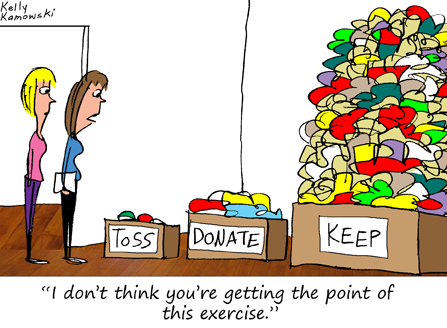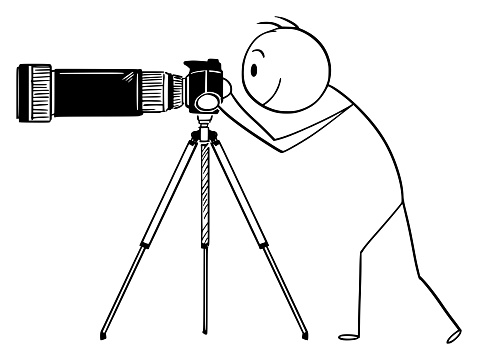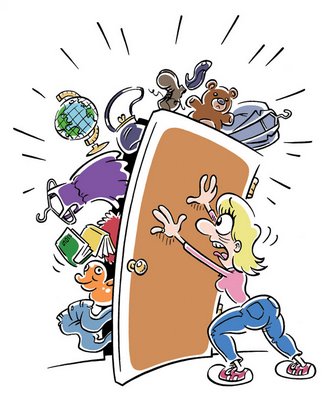Making Adjustments
We are all adjusting to our present environment. I stopped at Wegman’s on Friday afternoon and saw over 70 customers with masks standing about six feet apart and circling around half the huge store. It was a strange feeling and I felt like I was in an old Twilight Zone episode from the 1960’s. I believe the title of the episode could be “Social Distancing” since we hear this term so frequently. I believe it more accurately should be called “Physical Distancing”. Physical Distancing is a more appropriate description as we are looking to have physical distance but not looking to limit our social interaction. I am using Physical Distancing in this blog.
Organizing
I am in the auction business and have had the opportunity to work regularly with Professional Organizers. I have been impressed to recently learn a good number of Professional Organizers offer virtual organizing services. Even more impressive is how many have been virtually organizing with clients for years. Virtual Organizing maintains the physical distancing needed in our challenging environment while providing the social interaction and discipline to focus on tasks. I know this is not always easy when you try to organize alone…

What Can I Sell?
An auction specialist can efficiently help professional organizers and their clients as there is need to sell personal property by identifying valuable items through pictures. Pictures provided electronically (emails, texts, digital albums, etc.) are physical distancing appropriate and the timeliness and efficiency helps keep an organizing project moving forward.

The technology available to provide pictures including details like artist signatures and manufacturer or maker marks has been part of a dramatic change in the auction world over the past 25 years. Wait times to coordinate an initial visit and get started have largely been replaced with progress and information much more quickly through introductory phone conversations and pictures.
STUFFocating
There are many people who have inherited or collected items through the years and these items fill their storage spaces and extra rooms of their homes over time. Many of these clients are what I call “Stuffocating”.

Those feeling like they are Stuffocating do not know how to get started dealing with it all and have little idea which of their old and vintage items have value in today’s market. Their items look like they could be valuable or have family stories indicating they are valuable. I often hear comments like “Aunt Flossie said these were worth money” or “I saw one that looked just like this on “Antiques Road Show”. They often can use some help from a professional organizer and/or auction house to have an effective plan and make noticeable progress.
Physical Distancing for Bidders at Auction
Technology introduced over the past 25 years has helped the selling side of auctions to continue with physical distancing intact. Internet bidding platforms make it easy for buyers to bid on their cell phone, iPad, computer or any device connected to the internet.

Bidding by phone with an auction associate or leaving bids in advance is often available as well. Many auction houses have also added live online bidding available through their own websites.
Auction previews on-site are extremely limited presently. However, good online catalogs provide auction bidders with descriptions and auction estimates as well as an array of pictures showing detail for each item being sold. Online catalogs are typically available on the auction house website as well as the internet bidding platforms.
The Twilight Zone
We are in a dimension of challenge and spacing. Through technology and creativity, we can function in the world of organizing and auctions while we may feel like we are ….In the Twilight Zone.
Author is Tim Zeigler, Kamelot Auction House, www.kamelotauctions.com. Direct contact at 215-815-4983 and .
As an auction professional, I regularly have the opportunity to work with Professional Organizers and Senior Move Managers. These professionals provide a wonderful service helping client’s de-clutter their homes for a variety of reasons including preparation for sale, down-sizing & moving to a smaller living space or simply organizing their lives.
During the de-cluttering process, there is often a need to sell personal property and in some cases a great deal of property. Since auctions are a simple, efficient and often productive approach to selling, we can often help the same client. This is the wonderful connection between us.
I developed a passion for auctions as a child from my father. He loved auctions and would take me on his Saturday auction adventures to pretend he was helping my mother. He loved to buy at auction and mom did not appreciate clutter, so you can imagine the action at our home.
These auctions often had big crowds of people and enthusiastic bidding. It was exciting! I would hear energized bidders looking for a bargain. However, I was attracted to selling at auction as the price just went one direction. I have not come across another business negotiation where the price only goes higher. I loved the excitement of the auction environment as a child and still do today. However, the environment has changed.
I have heard these questions in recent years as we help clients looking to sell their property. A great many of these clients were at auctions forty, fifty or more years ago buying much of their art, furniture, antiques, decorative items and collections. They would often spend an entire day at the auction and there would be hundreds of people in attendance. They would see friends and enjoy the camaraderie.
I was reminded of the feeling when recently watching an old movie “North by Northwest”. There is a fascinating auction scene Alfred Hitchcock used in the story line. It showed bidding and activity at a high end auction over fifty years ago. The auction gallery was filled. People were sitting in every available seat and others were standing. There were no large screens displaying the auction item and no bidding by telephone or internet. There were no computers supporting the auction process at all. What a major difference!
Large screens, phone bidding and internet platforms have expanded the range and number of bidders dramatically. However, it does not look like it to auction buyers from many years ago turned into auction sellers as their lives have changed.
When asked where is everybody? Where are the bidders? I point out the number of ways the auctioneer is accepting bids beyond those from the smaller than they expected bidders attending in person.
I look toward the computers handing the bidding for each of the multiple
internet bidding platforms and explain each computer represents far more bidders than when you purchased in the crowded auctions many years ago. I look toward the staff members handling phone bidding and point out those strong bidders as well. There are also bids left with the office and on our web-site. I explain there is a larger geographic area represented and there are bidders watching the auction from not only our region but from the entire United States and around the world. I point out they have been able to see each item in a gallery of pictures for a month before the auction.
Once the auctioneer starts taking bids from the bidders in all these different ways (including from bidders in person like Alfred Hitchcock portrayed), it begins to make sense. Bidding at auction is even more exciting as it comes in so many ways from so many places!
As an auction professional, I regularly have the opportunity to work
with Professional Organizers and Senior Move Managers. These
professionals provide a wonderful service helping client’s de-clutter
their homes for a variety of reasons including preparation for sale,
down-sizing & moving to a smaller living space or simply organizing
their lives.

During the de-cluttering process, there is often a need to sell personal
property and in some cases a great deal of property. Since auctions are
a simple, efficient and often productive approach to selling, we can
often help the same client. This is the wonderful connection between
us.
I developed a passion for auctions as a child from my father. He loved
auctions and would take me on his Saturday auction adventures to
pretend he was helping my mother. He loved to buy at auction and
mom did not appreciate clutter, so you can imagine the action at our
home. These auctions often had big crowds of people and enthusiastic
bidding. It was exciting. I would hear energized bidders looking for a
bargain. However, I was attracted to selling at auction as the price just
went one direction. I have not come across another business
negotiation where the price only goes higher. I loved the excitement of
the auction environment as a child and still do today. However, the
environment has changed.
I have heard these questions in recent years as we help clients looking
to sell their property. A great many of these clients were at auctions
forty, fifty or more years ago buying much of their art, furniture,
antiques, decorative items and collections. They would often spend an
entire day at the auction and there would be hundreds of people in
attendance. They would see friends and enjoy the camaraderie. I was
reminded of the feeling when recently watching an old movie “North
by Northwest”.
There is a fascinating auction scene Alfred Hitchcock
used in the story line. It showed bidding and activity at a high end auction over fifty years ago. The auction gallery was filled. People were sitting in every available seat and others were standing. There were no large screens displaying the auction item. There was no bidding by telephone. There was no internet bidding. There were no computers supporting the auction process at all. What a major difference! Large screens, phone bidding and internet platforms have expanded the range and number of bidders dramatically.
However, it does not look like it to auction buyers from many years ago turned into auction sellers as their lives have changed.
When asked where is everybody? Where are the bidders? I point out
the number of ways the auctioneer is accepting bids beyond those from
the smaller than they expected bidders attending in person. I look
toward the computers handing the bidding for each of the multiple
internet bidding platforms and explain each computer represents far
more bidders than when you purchased in the crowded auctions many
years ago. I look toward the staff members handling phone bidding and
point out those strong bidders as well. There are also bids left with the
office and on our web-site. I explain there is a larger geographic area
represented and there are bidders watching the auction from not only
our region but from the entire United States and around the world. I
point out they have been able to see each item in a gallery of pictures
for a month before the auction.
Once the auctioneer starts taking bids from the bidders in all these
different ways (including from bidders in person like Alfred Hitchcock
portrayed), it begins to make sense. Bidding at auction is even more
exciting as it comes in so many ways from so many places!
People often wonder about the possible value of items they have accumulated over many years. These items are often viewed as “treasures” which may have significant resale value. Finding the “treasures” among their possessions often surfaces when:
 Many of the items accumulated may not have been purchased by the current owner including inherited items, gifts received, or collections of a spouse who has passed away.
Many of the items accumulated may not have been purchased by the current owner including inherited items, gifts received, or collections of a spouse who has passed away.
People often have a sense of the value of some of their valuables. However, in many cases the values are from past information or are based on a retail price that does not represent current resale value.
Many people research and try their hand at determining resale values. The internet is the most common resource used. There is a great deal of information available on the internet, so much so, that it can become overwhelming. However, it is possible to get a sense of what to expect in the current market. A few resources which are helpful, free, and fairly easy to use are EBay, Live Auctioneers, and Invaluable. Each of these resources provide a history of the selling price of items which have been offered through their sites. They provide the sales history with no charge once you have registered (registration is free). When researching items, it is important to look at the selling price results of the same or similar items. Using the asking price is not reliable because the seller can ask any price they would like for an item. Therefore, it is the selling price which provides a more accurate measure of resale value.
Often, another challenge is properly identifying the item to be valued. There are reproductions or copies which can be difficult to differentiate from originals. There are maker marks and signatures which are difficult to find and read. I have had clients get extremely excited about an item they saw on Antiques Road Show that was worth many thousand of dollars and looked just like the one they own. In most cases, there are subtle differences and their item is of much less value.
It is helpful to have the help of a trained eye. There are professional resources available to help identify the value of potential treasures:
A common question I receive relates to collectible plates and other collectible items which have been purchased on late night television throughout the decades. In most cases, there is little or no value to these items. When there are many of something sold to many collectors, the value does not often increase. The resale market is driven by supply and demand. When there is a large supply of collectible items made for collecting, there is rarely enough demand to make them valuable.
 Finding treasures is an adventure which is rewarding and disappointing at times. Enjoy the adventure and I wish you good luck as you treasure hunt.
Finding treasures is an adventure which is rewarding and disappointing at times. Enjoy the adventure and I wish you good luck as you treasure hunt.
Personal property is “in motion” when there is a need to deal with your movable personal possessions. Items include furnishings, art, antiques, jewelry, and collections — often referred to as “stuff.”
What puts Personal Property in Motion?
• Moving & down-sizing living space
• Selling a local home to move full-time to a vacation home
• Inheriting items when your home is already full
• Deciding to sell a personal collection
• Making a decorating/design change or upgrade
• Getting organized to deal with stuff which has accumulated over the years
• Settling an estate
Suggestions for dealing with emotions when Property is in Motion
• Pictures can help retain the memory of items. Remembering special rooms, spaces, items, and collections through picture albums can help minimize the sense of loss. The pictures, when stored and retrieved electronically, take up no physical space.
• Providing family and friends with the opportunity to acquire items helps in many cases. Passing along sentimental items, in this way, often feels good.
• Recognize it is now normal when family and friends are not interested in many of your furnishings and treasures. Unfortunately, I see this in the majority of people I have worked with in recent years. It helps to not take it personally. When this happens, it is time to sell, donate, or dispose.
Identifying and selling valuable personal property:
• Unfortunately, what you or your family paid for items does not matter to buyers.
• The buyers are generally significantly younger than the sellers. Current market value is driven by what buyers demand.
• When you look to sell valuables directly to a buyer, knowing the current market value is helpful in setting and negotiating a fair price.
• Auctions are an efficient way to deal with significant amounts of personal property in motion efficiently; there are auctions available at every level.
• Higher-end auction houses are an efficient resource in identifying valuable items and their market value; there is generally no charge for this service.
• When selling valuables at auction, it is important to use an auction house which regularly offers similar items. They will have established clientele and attract strong bidders.
Very often, a handful of the most valuable personal property items are worth as much as everything else (you’d hoped to sell) combined. When this happens, half of the financial work in handling the property in motion is complete, simply by identifying and selling the most valuable items.
The process of dealing with property “in motion” brings out emotion. There are memories attached to belongings which connect us to our family, friends, and occasions throughout our lives. While the process may have emotional ups and downs, it feels good when it is complete. I wish you well.
Click on the title above to learn more about the featured author.